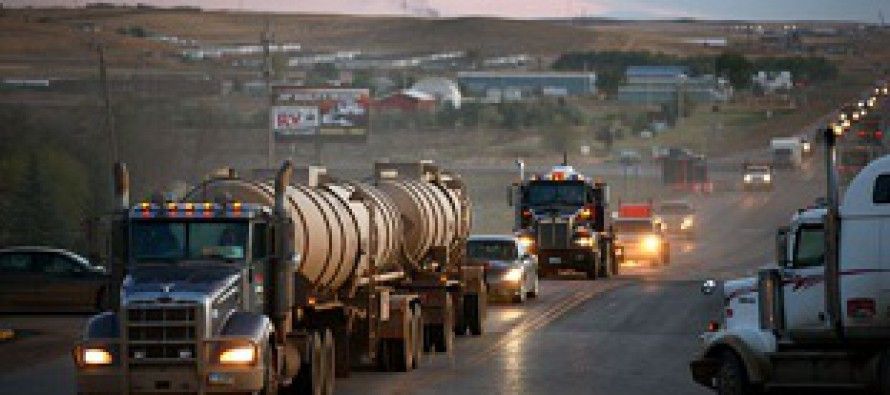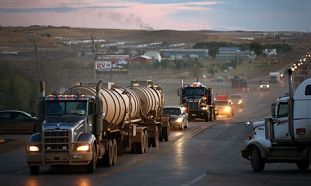What CA can learn from North Dakota’s stunning boom

 The boom that North Dakota’s enjoyed because of fracking is usually depicted in newspaper stories and network reports as being about housing shortages and a flood of in-migration driven by job hunters.
The boom that North Dakota’s enjoyed because of fracking is usually depicted in newspaper stories and network reports as being about housing shortages and a flood of in-migration driven by job hunters.
Rarely do accounts offer stark statistics that illustrate just how big the boom has been. Thankfully, a new American Enterprise Institute analysis does so in dramatic fashion.
In a dozen years, North Dakota went from being one of the nation’s poorest states, grouped with some Southern states, New Mexico and West Virginia, to one of the richest, trailing only another energy giant — Alaska. That’s a pretty stunning success story — comparable to Japan’s and West Germany’s delayed post-World War II rebound in the 1960s and early 1970s, or to South Korea’s emergence in the last 20 years as a nation that’s wealthier than most of Europe.
Here are the details from AEI:
“In 2000, North Dakota was the 8th least economically prosperous US states, ranking No. 43 in the country for per-capita real GDP that year … with GDP per person ($35,738) that was more than 20% below the national average ($44,808). In that year, North Dakota was a relatively minor oil-producing state, ranking ninth among the US states for oil production … .
“Starting around 2007, private oil drillers started successfully drilling for shale oil in North Dakota, thanks to advances in drilling and extraction technologies that allowed ‘petropreneurs’ to finally tap into oceans of previously inaccessible unconventional oil in the Bakken oil fields in the western part of the state. … In just the three years between 2007 and 2010, North Dakota moved up 18 places in state rankings for per-capita real GDP, from No. 30 in 2007 to No. 12 in 2010. …
“After more than doubling from 2007 to 2010, annual oil production in the Peace Garden State more than doubled again in the two-year period from 2010 to 2012 … North Dakota was producing so much shale oil in the Bakken that it surpassed both Alaska and California to become the nation’s second-largest oil-producing state in 2012, behind only Texas. … by 2012, the energy-driven stimulus to the state’s economy moved North Dakota to the No. 2 spot in the country for per-capita real GDP at $64,871 behind only Alaska at $72,281, and 33.6% above the national average of $48,567.
“In 2013, for the second year in a row, North Dakota again ranked No. 2 among US states for real GDP per capita at $68,804 … more than 40% above the national average.”
California could enjoy a similar miracle
 The AEI number-crunching bears huge relevance to California, where the Monterey Shale’s oil reserves in the Central Valley and central Pacific coastal counties are believed to be several times as big as those in the Bakken Shale.
The AEI number-crunching bears huge relevance to California, where the Monterey Shale’s oil reserves in the Central Valley and central Pacific coastal counties are believed to be several times as big as those in the Bakken Shale.
Federal energy officials have recently been more downbeat on California’s chances of accessing those reserves than they used to be, allegedly because of new concerns about geologic obstacles that they didn’t used to have. This doesn’t make sense — energy companies are better than ever at overcoming such obstacles. But it wasn’t all that surprising, given how often green bureaucrats pursue their own agendas.
Unsurprisingly, Occidental and other oil energy-exploration firms are far less apprehensive and continue to show great interest in expanding fracking of California’s shale. In its reports to shareholders — reports that Occidental must answer to the SEC for if they are judged deceptive — the energy company has estimated that California has more than 20 billion barrels of recoverable oil in its shale.
That’s more than twice as much as the rest of the U.S. combined. That’s 30 percent higher than the highest federal estimate before officials suddenly began to see geologic obstacles they hadn’t before.
2.8 million new CA jobs. Repeat: 2.8 million new CA jobs
That translates into a ton of money, to put it modestly. If anti-fossil fuel religious crusaders could be overcome, what might that mean for California? The USC report from March 2013 still seems like a good guide.
“Development of oil-shale deposits through Central California using fracking and other techniques may boost the state’s economic activity by as much as 14.3 percent, a University of Southern California study said.
“Such drilling in the Monterey Shale Formation, in addition to increasing per-capita gross domestic product, may add as much as $24.6 billion in state and local tax revenue and as many as 2.8 million jobs by 2020, according to the report … .”
Those numbers seemed outlandish to some folks when they came out 16 months ago. If you look at the AEI’s report on North Dakota, they don’t seem outlandish at all.
Related Articles
CA unemployment jumps to 8.9%
So much for California being “back,” as Gov. Jerry Brown keeps badgering us. State unemployment jumped to 8.9 percent in
Time to break up Los Angeles
March 8, 2013 By John Seiler Los Angeles obviously doesn’t work. The election of a new mayor, the first phase
Sacramento’s Delusions of Grandeur
Sacramento officials are still actively pursuing building a downtown sports arena and entertainment facility. Despite climbing unemployment in the region,



